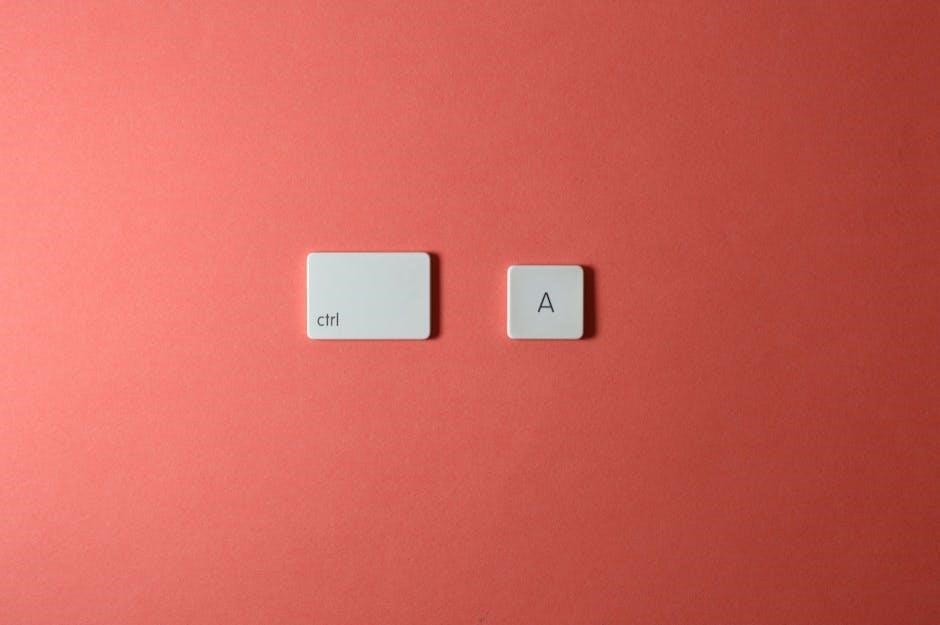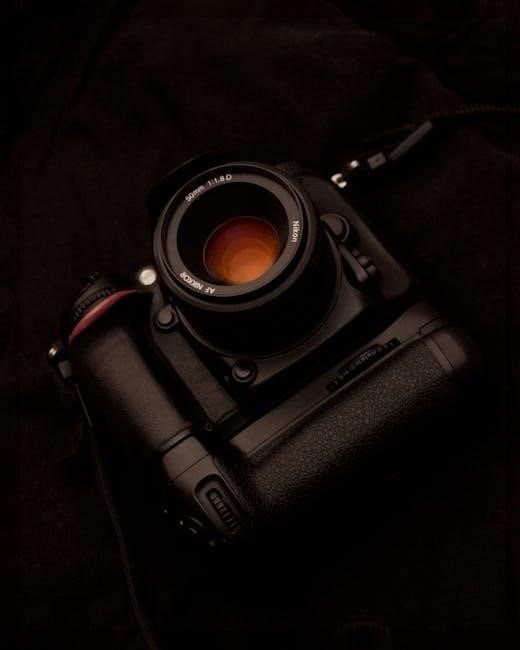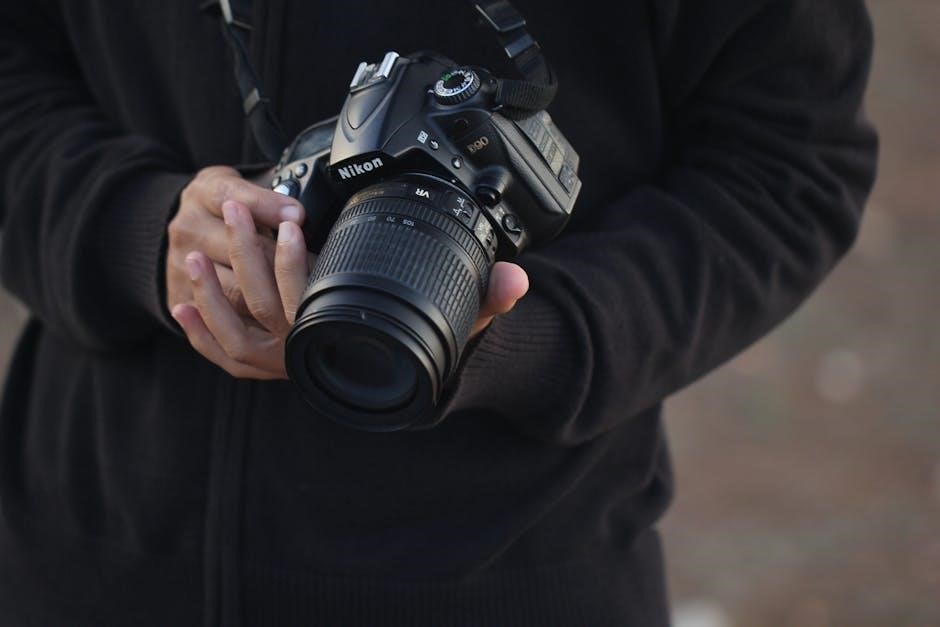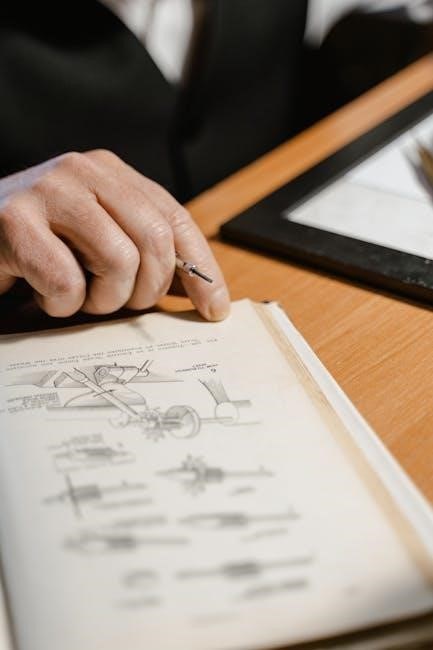Unlock the full potential of your Nikon D610 with this comprehensive guide. Designed to help you master its features, it provides a deep understanding of its capabilities.
1.1 Overview of the Nikon D610 Features
The Nikon D610 is a powerful DSLR camera featuring a 24.3MP full-frame sensor, delivering exceptional image quality. It offers a 39-point autofocus system, 6fps continuous shooting, and 1080p video recording. The camera includes dual SD card slots, a 3.2-inch LCD screen, and a long-lasting battery life. Its weather-sealed design ensures durability, while built-in HDR and multiple exposure modes enhance creativity. This versatile camera is ideal for both professionals and enthusiasts seeking high-performance photography.
1.2 Target Audience for the Nikon D610
The Nikon D610 is ideal for photography enthusiasts and professionals seeking a reliable DSLR. It caters to those who value high image quality, manual controls, and durability. Whether you’re upgrading from an entry-level camera or need a secondary body for professional work, the D610 offers the versatility and performance to meet your creative demands. Its weather-sealed design and advanced features make it suitable for various shooting conditions and styles.

Unboxing and Accessories
The Nikon D610 typically comes with the camera body, battery, charger, strap, and manual. Ensure all items are included for a complete setup experience.
Consider additional accessories like lenses, memory cards, and tripods to enhance your photography workflow and creativity with the Nikon D610.
2.1 What’s Included in the Box
The Nikon D610 box includes the camera body, an 18-55mm VR kit lens, rechargeable Li-ion battery, battery charger, USB cable, strap, body cap, and user manual. Additional items like a memory card and lens hood may be included depending on the bundle. Ensure all accessories are accounted for before setup.
2.2 Recommended Additional Accessories
To enhance your Nikon D610 experience, consider these essential accessories:
- Extra EN-EL15 batteries for extended shooting sessions.
- High-speed memory cards to ensure smooth performance.
- Nikon lenses to expand your creative possibilities.
- A sturdy tripod for stable long exposures.
- Remote shutter release to minimize camera shake.
- External flash units for advanced lighting control.
- Protective camera bag to safeguard your equipment.
These accessories will help you unlock the full potential of your Nikon D610.

Camera Design and Layout
The Nikon D610 features a robust, weather-sealed body with a magnesium alloy frame, ensuring durability. Its ergonomic grip and intuitive control layout enhance comfort and ease of use.
3.1 Exterior and Build Quality
The Nikon D610 features a durable magnesium alloy frame, ensuring robustness and weather-sealing for outdoor use. Its ergonomic design provides a comfortable grip, while the intuitive layout of buttons and controls enhances usability. The camera’s build quality supports precise control, making it ideal for photographers seeking reliability and performance in various conditions.
3.2 Key Controls and Buttons
The Nikon D610 features intuitive controls, including the mode dial, shutter release, and ISO/white balance buttons on the top. The rear includes the multi-selector for navigation, the “i” button for quick settings, and the live view switch. The customizable Fn button and command dials provide easy access to key functions. The AF-mode button near the lens mount allows quick switching between autofocus modes, enhancing shooting efficiency and creativity.

Getting Started
Begin by familiarizing yourself with the Nikon D610’s basic settings and controls. This guide provides a clear path to understanding initial setup and essential camera operations.
4.1 Initial Setup and Basic Settings
Begin by unpacking and charging the battery. Insert the battery into the camera and mount the lens. Install the memory card and set the language, date, and time. Navigate to the menu to configure basic settings like image quality and autofocus mode. Set the shooting mode to Auto or P for beginners. Refer to the manual for detailed guidance on customizing your initial setup for optimal performance.
4.2 Charging and Battery Management
The Nikon D610 uses an EN-EL3e lithium-ion battery, which provides excellent performance. Charge it using the MH-18a charger. Avoid overcharging to maintain battery health. Ensure the battery is fully charged before use. For optimal performance, update the camera’s firmware periodically. Store unused batteries in a cool, dry place. Always use genuine Nikon accessories to prevent damage and ensure reliability.
Understanding Exposure Modes
Master exposure control with Auto Mode for simplicity, Scene Modes for specific scenarios, and Manual Mode for full creative control over aperture, shutter speed, and ISO settings.
5.1 Auto Mode and Scene Modes
The Nikon D610 offers an intuitive Auto Mode for effortless photography, automatically adjusting settings for optimal results. Additionally, various Scene Modes are available, such as Portrait, Landscape, and Night Portrait, which tailor settings to specific shooting scenarios. These modes simplify photography, allowing users to capture stunning images without manual adjustments, making them ideal for beginners or quick shots.

5.2 Manual Mode (M) and Custom Settings
Manual Mode (M) on the Nikon D610 offers full creative control, allowing you to adjust aperture, shutter speed, and ISO independently. Custom settings enable personalization, such as assigning functions to buttons or configuring autofocus preferences. These features empower photographers to tailor the camera to their unique shooting style, enhancing efficiency and creativity during capture.
Autofocus and Metering
The Nikon D610 features an advanced 39-point autofocus system for precise subject tracking. Metering modes include Matrix, Center-Weighted, and Spot options for accurate exposure control in various lighting conditions.
6.1 Autofocus Modes and Configuration
The Nikon D610 offers advanced autofocus capabilities with multiple modes. Single AF (AF-S) is ideal for stationary subjects, while Continuous AF (AF-C) tracks moving subjects. Manual AF (M) allows precise focus control. The camera also features customizable AF configurations, enabling users to assign specific AF modes to buttons for quick access. This flexibility ensures optimal performance in various shooting scenarios, enhancing your photography experience. Use the menu system to tailor AF settings to your style.
6.2 Metering Modes and Exposure Compensation
The Nikon D610 offers multiple metering modes, including Matrix, Center-Weighted, and Spot metering, to accurately measure light in various conditions. Exposure compensation allows fine-tuning of brightness by adjusting +/-5 EV in 1/3-stop increments. This ensures precise control over lighting, enabling photographers to achieve balanced exposures effortlessly, even in challenging scenarios.

White Balance and ISO Settings
Master White Balance for accurate colors and explore ISO settings to balance brightness and noise, ensuring optimal image quality in various lighting conditions with precision control.
7.1 Understanding White Balance Options
The Nikon D610 offers various white balance options to ensure accurate color representation. Presets like Auto, Daylight, Fluorescent, and Cloudy adapt to lighting conditions. Custom white balance allows manual adjustment for precise control. Use the menu or dedicated buttons to select options, ensuring natural tones in your images. Experiment with settings to enhance creativity and achieve optimal results in different environments.
7.2 ISO Sensitivity and Noise Reduction
The Nikon D610 offers an ISO range of 100 to 6400, extendable to 25,600. Lower ISOs (100-400) are ideal for bright conditions, minimizing noise. Higher ISOs (1600-6400) are suited for low-light scenarios but may introduce grain. The camera features built-in noise reduction, which helps maintain image clarity, especially in high ISO shots. Balancing ISO and noise reduction ensures crisp, detailed photos across various lighting conditions.

Image Quality and File Formats
The Nikon D610 captures high-resolution images with precise detail. It supports both JPEG and RAW formats, offering flexibility for editing and storage needs.
8.1 JPEG vs. RAW File Formats
Understanding file formats is crucial for optimizing your Nikon D610 workflow. JPEG files are processed and compressed, making them ready for sharing but limiting post-processing flexibility. RAW files, like Nikon’s .NEF format, capture unprocessed sensor data, offering greater editing potential but requiring more storage space. Choose RAW for professional-grade edits or JPEG for convenience and smaller file sizes.
8.2 Image Size and Quality Settings
Master the Nikon D610’s image size and quality settings for optimal results. Choose from various resolutions like FX (36×24) and DX (24×16) formats. Adjust quality settings between Fine, Normal, and Basic to balance file size and compression. These options ensure your photos meet your creative and technical needs, whether for printing or digital use.
Flash and Lighting
Master the Nikon D610’s flash and lighting capabilities. The built-in flash and external options enhance your photography, providing optimal illumination in various lighting conditions for stunning results.
9.1 Built-in Flash and External Flash Options
The Nikon D610 features a built-in flash, ideal for casual photography, with a guide number of 12/39 (m/ft) at ISO 100. It covers a 24mm lens angle and supports i-TTL flash control. For advanced lighting, external Speedlight units like the SB-500 or SB-700 can be mounted via the hot shoe or triggered wirelessly using the D610’s commander mode, offering greater flexibility and creative control over lighting setups.
9.2 Using Flash in Different Lighting Conditions
Master the Nikon D610’s flash system by understanding its use in various lighting scenarios. In low-light conditions, the built-in flash illuminates subjects effectively, reducing shadows. For backlight, use the flash to balance exposure and avoid silhouettes. In bright conditions, the flash can fill shadows, enhancing portraits. Adjust flash intensity and experiment with diffusers for softer light. Explore these techniques to capture stunning images in any lighting environment with precision and creativity.
Viewfinder and LCD Display
The Nikon D610 features a clear optical viewfinder and a detailed 3.2-inch LCD screen, essential for precise composition, reviewing shots, and adjusting settings with ease.
10.1 Understanding the Viewfinder Information
The Nikon D610’s viewfinder displays essential shooting data, including aperture, shutter speed, and ISO. It also shows metering mode, focus points, and battery level. The viewfinder provides a 100% frame coverage, ensuring accurate composition. Icons indicate active AF points, and a grid can be enabled for better alignment. This information helps you adjust settings and compose shots efficiently without relying on the LCD screen.
10.2 Using the LCD for Live View and Playback
The Nikon D610’s 3.2-inch LCD screen is ideal for Live View shooting and image playback. Activate Live View with the dedicated button for real-time preview and precise composition. During playback, browse images, zoom in for details, and review histograms. Use the multi-selector to navigate and adjust settings. The LCD’s clarity enhances your shooting and post-capture experience, making it essential for refining your photography skills.
Customizing Your Camera
Customize your Nikon D610 to suit your photography style. Utilize the custom menu to personalize settings and assign functions to buttons for streamlined workflow and enhanced creativity.
11.1 Custom Menu Options
The Nikon D610 offers a customizable menu system, allowing you to tailor settings to your preferences. Access the custom menu to personalize shooting options, such as autofocus modes, metering, and button assignments. This feature enhances workflow efficiency by letting you quickly adjust settings that suit your photography style. Explore the menu to unlock advanced customization options and optimize your camera for specific shooting scenarios.
11.2 Assigning Functions to Buttons
Customize your Nikon D610 by assigning functions to buttons for enhanced control. Access the custom menu to reassign roles to buttons like Fn, Preview, or AE-L/AF-L. This feature allows you to tailor the camera to your shooting style, improving efficiency and comfort during photography sessions. Personalize your workflow by assigning frequently used functions to easily accessible buttons, ensuring a more intuitive and streamlined shooting experience.

Shooting Techniques
Master your Nikon D610 with expert techniques. Learn composition tips, lighting strategies, and optimal camera settings for stunning results in various photography scenarios and conditions.
12.1 Shooting in RAW vs. JPEG
Shooting in RAW captures more image data, offering greater flexibility in post-processing. It retains details in shadows and highlights, ideal for professional editing. JPEG files are smaller, with compressed data, suitable for sharing and everyday use. RAW is recommended for high-quality results and creative control, while JPEG is practical for quick access and storage efficiency. Choose based on your workflow and image needs.
12.2 Tips for Better Composition
- Use the rule of thirds to balance your frame and create dynamic shots.
- Experiment with leading lines to guide the viewer’s eye through the image.
- Frame your subject with natural or man-made elements for depth.
- Shoot from low or high angles to add creativity to your perspective.
- Focus on symmetry and patterns to capture visually appealing scenes.
- Pay attention to lighting and shadows to enhance mood and texture.
- Keep it simple—avoid clutter to emphasize your subject.
- Capture details to tell a story or highlight unique features.
These tips will help you elevate your photography and create visually stunning images with your Nikon D610.
Maintenance and Troubleshooting
Regularly clean the sensor and lens for optimal performance. Check for firmware updates and address common issues like error messages or battery drain promptly for smooth operation.
13.1 Cleaning the Sensor and Lens
Regular cleaning of the sensor and lens is crucial for maintaining image quality. Use a soft brush or blower to remove dust. For stubborn spots, gently wipe with a microfiber cloth and cleaning solution. Avoid touching the sensor with bare hands or using harsh chemicals. Clean the lens with a microfiber cloth, avoiding circular motions. Always handle with care to prevent scratches and damage. Ensure the camera is powered off or on a fully charged battery/AC adapter during cleaning.
13.2 Common Issues and Solutions
Addressing common issues with your Nikon D610 ensures optimal performance. Error messages like “CARD NOT FORMATTED” can be resolved by formatting the memory card in-camera. Battery life concerns? Ensure proper charging and avoid over-discharging. Autofocus issues? Clean the lens and sensor regularly. For blurry images, check autofocus settings or manual focus adjustments. Consult the manual for detailed troubleshooting steps to maintain peak functionality.

Advanced Features
Explore advanced capabilities like HDR, multiple exposure, and time-lapse photography. These features enhance creativity, allowing you to capture stunning images with precision and artistic control.
14.1 HDR and Multiple Exposure
The Nikon D610 offers HDR (High Dynamic Range) and Multiple Exposure features to enhance your photography. HDR combines multiple shots to capture a wider dynamic range, while Multiple Exposure allows blending up to three images. These modes are accessed via the shooting menu, enabling you to create stunning, detailed images with creative flexibility. Use these features to push your photography to new artistic levels.
14.2 Time-Lapse Photography
Capture stunning time-lapse sequences with the Nikon D610. Use the Time-Lapse Photography mode to set intervals between shots. A tripod is essential for stability. Choose intervals based on the scene, from seconds to hours. Large memory cards are recommended. Shoot in RAW for flexibility. Ideal for sunsets, clouds, or stars. Experiment with intervals to create smooth transitions. This feature transforms moments into mesmerizing videos, showcasing dynamic changes over time.
15.1 Summary of Key Features
The Nikon D610 offers exceptional image quality, robust build, and advanced features, making it a versatile tool for photographers of all skill levels.

15.2 Final Tips for Mastering the Nikon D610
Experiment with modes, practice techniques, and explore customization options to unlock its full potential and capture stunning images effortlessly.
The Nikon D610 offers a 24.3MP full-frame sensor, EXPEED 3 processor, and weather-sealed body. It features 39-point autofocus, 6fps continuous shooting, and ISO 50-25600 range. Dual memory card slots, HDR mode, and time-lapse functionality enhance versatility. The camera supports both JPEG and RAW formats, ensuring high-quality images. This guide helps enthusiasts and professionals master these features, unlocking creative potential for stunning photography.
Mastering the Nikon D610 requires practice and exploration. Experiment with manual modes to understand lighting and composition. Regularly review your photos to identify areas for improvement. Use the camera’s custom settings to streamline your workflow. Explore advanced features like HDR and time-lapse for creative results. Keep the camera and lenses clean for optimal performance. Lastly, stay updated with new techniques and resources to fully unlock your camera’s potential.
